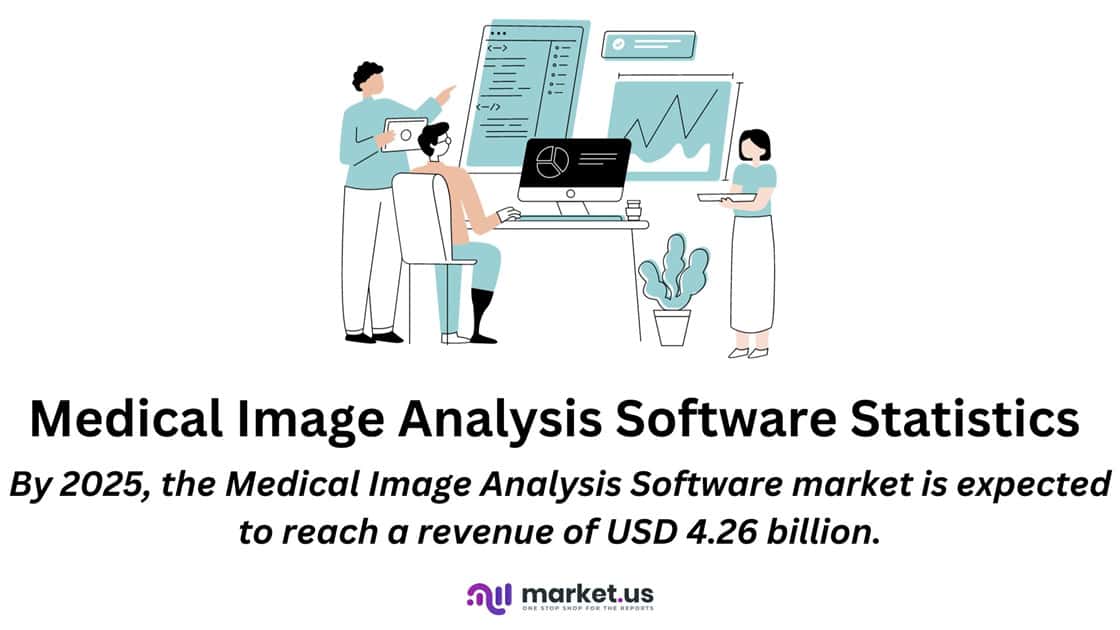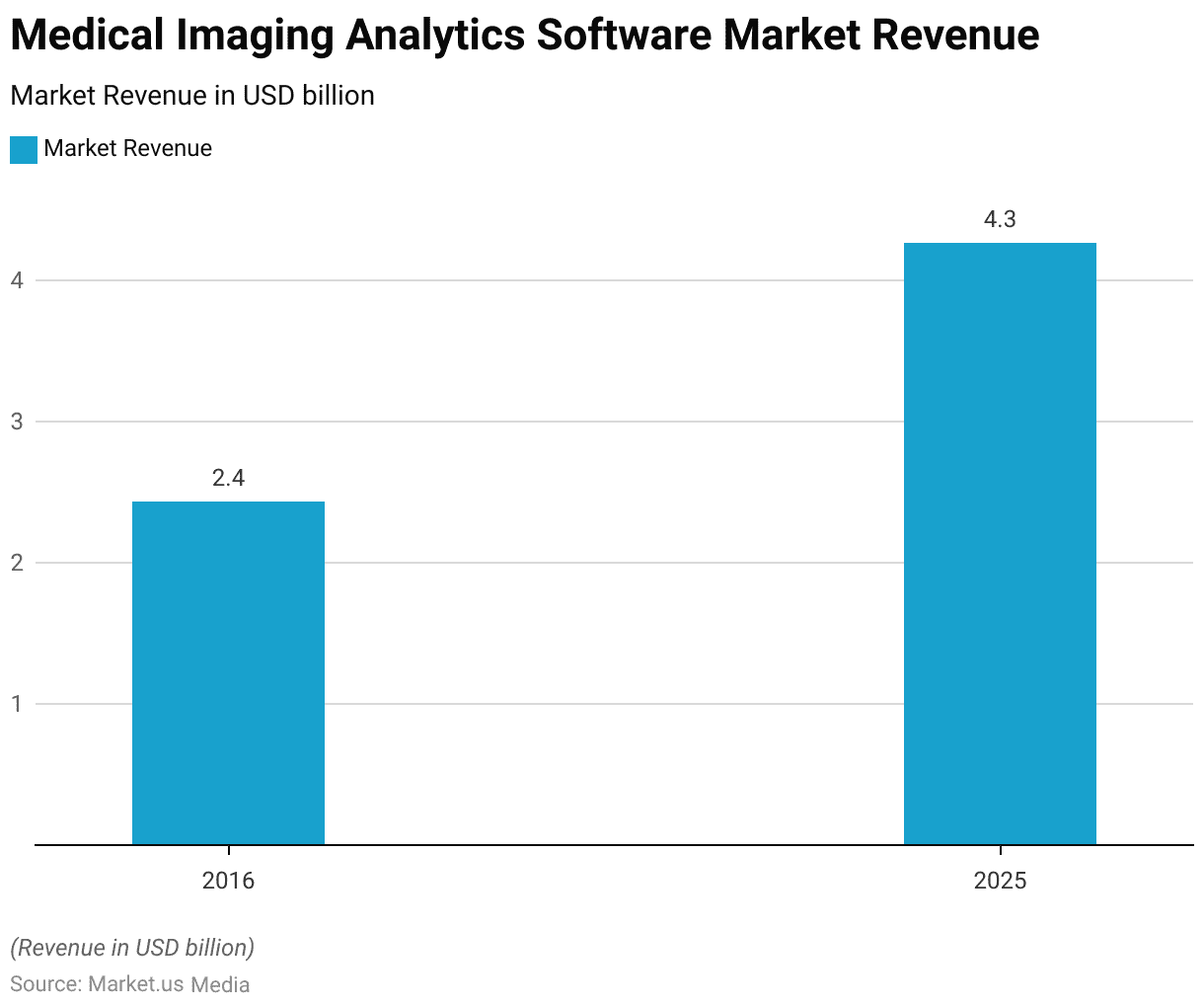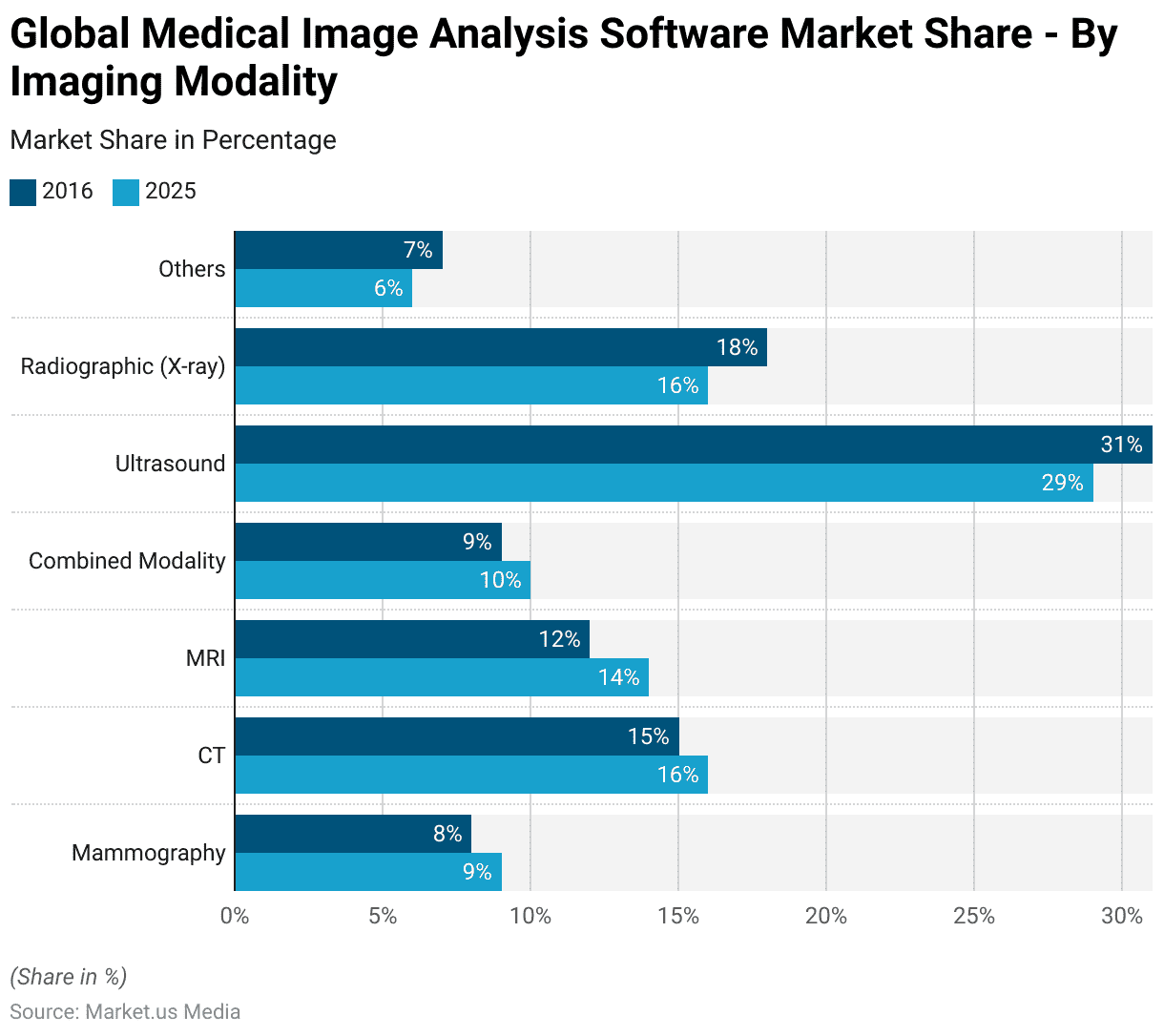Table of Contents
Introduction
Medical Image Analysis Software Statistics: Medical Image Analysis Software plays a vital role in contemporary healthcare by assisting healthcare experts in precise diagnosis, treatment strategy development, and research activities. It improves image clarity, identifies particular areas of interest, and delivers exact measurements.
Notable trends encompass its smooth incorporation into healthcare systems, reliance on cloud-based solutions, and the rise of personalized medical approaches. Obstacles encompass data security and adherence to regulations.
Nonetheless, the software’s future looks bright, fueled by technological advancements and the increasing need for precise medical solutions.

Editor’s Choice
- By 2025, the Medical Image Analysis Software market is expected to reach a revenue of USD 4.26 billion.
- By 2025, in terms of product distribution, standalone software’s market share is anticipated to decline to 37%, and integrated solutions will rise to a 42% share.
- Concerning imaging modality, Mammography, which accounted for 8% of the market share in 2016, is expected to see a slight increase to 9% by 2025.
- North America emerged as the leading region in 2016, with a market size of USD 780.8 million. And is expected to further expand its dominance, reaching USD 1,310.8 million by 2025.
- In 2021, the field of cardiology represented a substantial portion, accounting for 20%, of the radiology image analysis software market.
- In 2022, an estimated 28,600 women in Canada received a breast cancer diagnosis. With a quarter of them being newly diagnosed cases.
- Between 2010 and 2013, there was a clear uptick in the percentage of X-rays and MRIs conducted within 30 days following the initial medical consultation.
Global Medical Image Analysis Software Market Overview
Global Medical Image Analysis Software Market Size Statistics
- The revenue generated by the Medical Imaging Analytics software market has exhibited significant growth over the years.
- In 2016, it stood at USD 2.43 billion, marking the beginning of its trajectory.
- Fast forward to 2025, and the market has experienced substantial expansion, reaching a revenue of USD 4.26 billion.
- This impressive growth reflects the increasing adoption of medical imaging analytics software within the healthcare industry.
- The software’s capabilities in enhancing diagnostic accuracy, treatment planning, and research have contributed to its market prominence.
- These numbers signify not only the financial aspect but also the growing importance of advanced analytics tools in modern healthcare practices, indicating a promising future for the industry.
(Source: Statista)

Global Medical Image Analysis Software Market Share- By Product Statistics
- The Global Medical Image Analysis Software market has witnessed notable shifts in product distribution over the years.
- In 2016, standalone software held a majority share at 63%, while integrated solutions accounted for 58% of the market.
- However, a significant transformation occurred by 2025, with standalone software’s market share declining to 37%, and integrated solutions rising to a 42% share.
- These changes reflect evolving preferences and needs within the healthcare industry.
- The decline in standalone software usage indicates a shift towards more comprehensive and integrated solutions. Which offer enhanced functionality and seamless integration with healthcare systems.
- This shift in market share suggests a growing demand for cohesive and efficient medical image analysis software solutions in the coming years.
(Source: Statista)

Global Medical Image Analysis Software Market Share- By Imaging Modality
- In the global medical image analysis software market, an analysis of market share by imaging modality reveals interesting trends between 2016 and the projected figures for 2025.
- Mammography, which accounted for 8% of the market share in 2016, is expected to see a slight increase to 9% by 2025.
- CT imaging modality is poised to grow from 15% to 16% during this period.
- MRI, another critical imaging method, is also on the rise, going from 12% in 2016 to 14% in 2025.
- Combined modality imaging is anticipated to experience a minor increase, going from 9% to 10%.
- However, ultrasound, which had the largest market share in 2016 at 31%, is projected to see a slight decline to 29% by 2025.
- Radiographic (X-ray) imaging is expected to decrease from 18% in 2016 to 16% in 2025.
- Lastly, other imaging modalities are set to decrease from 7% to 6% during this period.
- These trends reflect the dynamic nature of the medical image analysis software market. With shifts in preferences and technology adoption within various imaging modalities.
(Source: Statista)

Global Medical Image Analysis Software Market Share- By Region
- The global medical image analysis software market exhibits notable regional variations in terms of market size, with data comparing 2016 figures to projected values for 2025.
- North America emerged as the leading region in 2016, with a market size of USD 780.8 million. It is expected to further expand its dominance, reaching USD 1,310.8 million by 2025.
- Europe, following closely behind, had a market size of USD 743.6 million in 2016 and is projected to reach USD 1,215.1 million by 2025.
- In the Asia Pacific region, the market was valued at USD 614 million in 2016 and is anticipated to grow significantly, reaching USD 1,146.1 million in 2025.
- Meanwhile, the Rest of the World region started at USD 125.5 million in 2016, and although it shows growth. It is still relatively smaller compared to the aforementioned regions, with a projected value of USD 264.7 million by 2025.
- These figures underscore the regional dynamics and potential opportunities within the global medical image analysis software market.
(Source: Statista)
Take advantage of our unbeatable offer - buy now!


Applications of Medical Image Analysis Software Statistics
Cardiology
- In 2021, the field of cardiology represented a substantial portion, accounting for 20%, of the radiology image analysis software market.
- This correlation aligns with the fact that cardiovascular disease ranks as the second leading cause of death in Canada. Notably, advanced algorithms play a pivotal role in various aspects of cardiovascular image analysis.
- As a recent example, Cleerly Proxy, a software solution is designed to streamline the process of transferring CT angiograms from local systems to Cleerly’s cloud service.
- This innovative software package is remarkably efficient, as it can be swiftly installed and configured within minutes.
- This not only saves valuable time but also reduces security vulnerabilities associated with each Cleerly heart analysis.
- Moreover, it empowers healthcare professionals to expedite and enhance the precision of identifying atherosclerosis. A condition characterized by the thickening or hardening of arteries.
(Source: Cleerly)
Dentistry
- In dentistry, making decisions based on images poses a unique challenge due to the complex and compact structures within the oral cavity.
- The presence of numerous small and overlapping features, coupled with variations in tooth sizes, shapes, and positions, makes the analysis a daunting task.
- Fortunately, medical image analysis software has emerged as a valuable tool for dentists, enhancing both diagnostic accuracy and workflow.
- This software can identify issues like tooth decay and bone diseases such as osteoporosis. Furthermore, it proves invaluable in the design of orthodontic devices and dental prosthetics.
- For instance, consider 3Dme Crown, an automated crown design module. It utilizes AI technology and patient’s 3D scan data to swiftly generate a tailored crown prosthesis design that perfectly suits the patient’s oral conditions.
- This design can then be promptly forwarded to a 3D printer or milling machine for immediate prosthesis production.
- This innovation has significantly reduced the time required for dental clinics and laboratories to create crown prostheses, a process that once took several days.
- Notably, it also minimizes the number of patient visits and enhances overall treatment satisfaction.
(Source: 3Dme)
Neurology
- In the field of brain imaging, AI algorithms play a crucial role in aiding healthcare professionals to identify subtle brain abnormalities that would otherwise remain undetectable.
- Consider epilepsy, a condition affecting approximately 70 million individuals worldwide.
- Notably, for a third of those with epilepsy, conventional medications fail to control their seizures, and determining the most effective treatment for each patient remains a challenge for clinicians.
- In a clinical study conducted by epilepsy researchers in Canada, a machine-learning model was trained to analyze brain scans of epilepsy patients, even when no apparent signs of the condition were visible in standard MRI scans.
- The outcome of this endeavor proved highly beneficial, as it enabled researchers to pinpoint the source of seizures in two female patients. Ultimately playing a pivotal role in the planning of surgical interventions.
(Source: Epilepsy Society)
Breast Oncology
- In 2022, an estimated 28,600 women in Canada received a breast cancer diagnosis, with a quarter of them being newly diagnosed cases.
- Therefore, the accurate detection of tumors remains a critical aspect of breast imaging.
- Recent research published in The Lancet Digital Health indicates that when radiologists collaborate with AI assistance, their screening for breast cancer is more effective compared to working independently.
- Additionally, this AI software exhibits improved performance when utilized alongside radiologists rather than operating autonomously.
(Source: Canadian Cancer Society, Lancet Digital Health)
MIPAV Application
- The MIPAV software, which stands for Medical Image Processing, Analysis, and Visualization, supports the quantitative assessment and visual representation of medical images from various sources, including PET, MRI, CT scans, and microscopy.
- Utilizing MIPAV’s user-friendly interface and analytical tools, researchers located in different places can easily collaborate and exchange research data and analyses through the Internet.
- This capability amplifies their ability to engage in research, diagnose medical conditions, track progress, and devise treatment approaches.
- MIPAV functions as a Java application, ensuring compatibility with Java-enabled systems like Windows, UNIX, and Macintosh OS X.
- The installation packages for MIPAV are created using the multi-platform installer builder known as install4j, and optimizations in the MIPAV codebase are accomplished using the Java profiler called JProfiler.
(Source: National Institute of Health)
Medical Image Analysis Software Usage Trends
- Between 2010 and 2013, there was a clear uptick in the percentage of X-rays and MRIs conducted within 30 days following the initial medical consultation.
- In both of these years, approximately 40 percent of lumbar spine X-rays and more than 60 percent of lumbar spine MRIs carried out within the initial 30-day timeframe were determined to be medically unnecessary.
- This same trend was evident in instances of knee and shoulder pain. Over 30 percent of MRIs were considered inappropriate in both years, even when looking at a 60-day window.
- Patients who underwent these unnecessary MRIs were notably less inclined to undergo surgery for their condition within 90 days. Implying a decreased sense of medical urgency compared to those for whom MRI imaging was deemed medically justified.
- Upon analyzing expenditure data specifically for the Massachusetts study population, it was estimated that commercial insurers incurred costs. Ranging from $4.6 to 5.5 million for these unjustified imaging procedures related to these three conditions over the two-year study duration.
(Source: NIHCM Foundation)
Medical Image Analysis Software Challenges
- In 2019, there were incidents of security breaches targeting medical protocols and file formats.
- Notable instances within the realm of PACS and medical imaging included instances like embedding malicious software within a DICOM image and the utilization of AI techniques to manipulate medical images.
- A German security firm named Greenbone Networks identified a concerning situation where nearly 24 million patient examinations. Comprising over 720 million images, were left exposed on 187 insecure servers in the United States.
- Alarmingly, two months later, this number of exposed servers had doubled, leading to a serious breach of privacy.
- Consequently, the U.S. government imposed fines on several medical imaging companies. One Tennessee-based company is being required to pay a penalty of $3 million for inadvertently exposing a server containing the confidential data of over 300,000 patients.
(Source: Tata Elixsi)
Recent Developments
Major Acquisitions:
- GE HealthCare announced the acquisition of MIM Software Inc., a provider of imaging analysis software. Aiming to enhance its advanced visualization product lines with AI-powered segmentation and analysis capabilities.
- Danaher’s acquisition of Abcam for $5.7 billion, gives the company entry into the protein consumables market. It reflects the strategic moves within the broader medical technology sector that include imaging analysis.
Technological Advancements:
- Innovations in the software are focusing on improving the functionality and integration of AI in medical imaging, which aids in more precise diagnostics and treatment planning.
Market Trends by Region:
- In Europe, there is significant growth due to advancements in imaging technologies like MRI and CT scans, particularly in countries like the UK, Germany, and France.
- The Asia Pacific region is experiencing rapid growth driven by increased adoption of advanced medical technologies and rising healthcare expenditure, especially in China and Japan.
Regulatory and Ethical Considerations:
- As the medical image analysis software sector grows, it continues to navigate complex regulatory environments. Ensuring compliance with health authorities and addressing ethical considerations around the use of AI and patient data.
Conclusion
Medical Image Analysis Software Statistics – In summary, Medical Image Analysis Software plays a pivotal role in modern healthcare by enhancing diagnostic accuracy through the analysis of medical images from various modalities.
Recent collaborations between radiologists and AI algorithms have demonstrated promising outcomes, particularly in areas like breast cancer detection. Nevertheless, challenges such as appropriate imaging utilization and data security must be addressed.
The financial impact of unnecessary imaging underscores the need for efficient resource allocation. As healthcare continues to evolve, this technology remains at the forefront of innovation, promising even greater capabilities in the future.
FAQs
Medical Image Analysis Software is a specialized tool designed for the quantitative analysis and visualization of medical images obtained from various modalities like MRI, CT scans, X-rays, and more. It aids healthcare professionals in diagnosing and monitoring medical conditions.
This software leverages advanced algorithms and image-processing techniques to extract meaningful information from medical images. It can enhance image quality, segment regions of interest, and provide quantitative measurements.
The software improves diagnostic accuracy, aids in treatment planning, enables precise measurements, and enhances visualization of medical images. It also allows for remote collaboration and data sharing among healthcare professionals.
Yes, AI and machine learning can be integrated into these software solutions to automate tasks, detect abnormalities, and assist radiologists and clinicians in image interpretation.
Challenges include ensuring appropriate utilization of imaging procedures, addressing data security concerns, and optimizing resource allocation. Additionally, the software’s effectiveness depends on the quality of input data.
Discuss your needs with our analyst
Please share your requirements with more details so our analyst can check if they can solve your problem(s)



